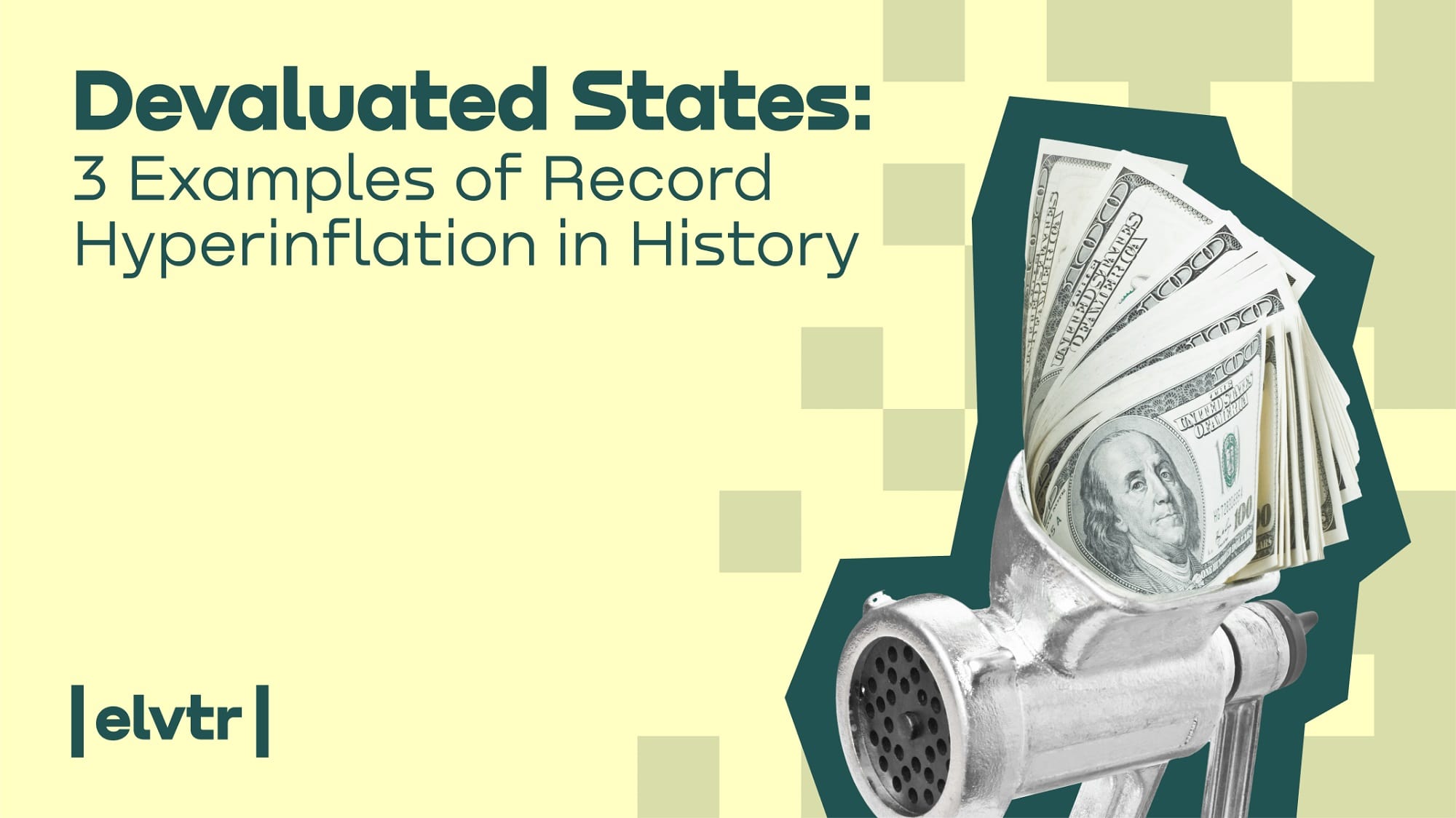- MAIN PAGE
- – elvtr magazine – DEVALUATED STATES: 3 EXAMPLES OF RECORD HYPERINFLATION IN HISTORY
DEVALUATED STATES: 3 EXAMPLES OF RECORD HYPERINFLATION IN HISTORY

Inflation can be considered normal as long as it is controllable and does not exceed 2% per year. However, there are many examples in history when the devaluation of the national currency reached 100% or more.
In this article, we analyzed 3 most outstanding cases.
The Essence of Hyperinflation
This is a process when the cost of products in the market increases rapidly due to the currency devaluation. Usually, state authorities control inflation, but sometimes the situation can get out of control. This is when hyperinflation occurs. It can be determined according to the following criteria:
Consequences of hyperinflation:
- money loses its basic properties
- prices increase rapidly
- massive bankruptcies, debt defaults
- citizens are unable to make savings
- unemployment is rising
- economic downturn
- collapse of the state’s financial system
#1. Hungary
Period: August 1945 – July 1946
Inflation rate: 207% per day
Currency: pengo
The Hungarian currency, pengo, holds the inflation record in the world economy: prices on the country's market doubled every 15 hours. This means that pengo was devaluating faster than any other currency in the world. The maximum inflation per month reached 40,000,000,000,000,000%. Why did this happen in Hungary?
Background: the country was already familiar with inflation before 1945-1946. As a result of the First World War, the Austro-Hungarian Empire collapsed. A new state, Hungary, appeared in Eastern Europe. It included a less-developed part of the former empire. The political institutions of this newly formed country were too weak.
Hungary decided to print more money to fill a hole in the budget. This became the cause of the disaster: for example, in the 1910s, $1 cost 5 Hungarian Kronen, and in 1924 – already 70 thousand. However, state authorities managed to take the inflation under control then. In 1926, Hungary replaced Kronen with a new currency, the pengo.
The course of events: during World War II, Hungary again fought on the side of Germany. By 1945 the country was in ruins. Half of the production facilities were destroyed; the rest were badly damaged. Almost nothing was left of the transport infrastructure. Apart from anything else, Hungary had to pay reparations to the USSR – compensation for its participation in the Axis Alliance.
The prices of goods in post-war Hungary started increasing due to the lack of production. The country had no tax system then, so there was nothing to fill the budget with. Then the government decided to boost the economy in a "proven" way, i.e., printed more banknotes and, at the same time, lower interest rates. As a result, Hungary was literally flooded with money that was backed by nothing.
In August 1945, $1 cost 1,320 pengos, after 2 months it was already 8,200, and by the end of the year, $1 cost 128,000 pengos. The government had to introduce banknotes in denominations of 100 thousand, 1 million, and 10 million.
Hyperinflation in Hungary reached its climax in the autumn of 1946 when the usual pengo was replaced by adopengo. The bill was equal to a billion trillion, or sextillion pengo. It was the largest banknote in the world, which is an absolute record in the history of world economy.
At the peak of inflation, prices were increasing at a rate of 150,000% per day (!). The government tried to take at least some measures to take control of the process, but it was too late.
Real wages dropped more than 80% due to hyperinflation. Lenders disappeared as a class. There was no point in lending people money at interest under such conditions. The only way out was denomination – replacing the old currency with a new one.
In 1946, the government conducted a monetary reform: the Hungarian forint put into circulation was equal to 400 thousand quadrillion pengos. The Hungarians still use the new currency.
The hyperinflation in Hungary was peculiar since it was a planned step and not the government's fiscal irresponsibility. Such a controversial plan worked out in the end.
The introduction of a new currency saved the state's economy. Unlike other countries in this article, Hungary quickly "recovered" from the monstrous inflation. By the time the forint was introduced, the industry had recovered, and the economy was working. The government did not start the printing press again, and prices in Hungary remained stable until the 60s. However, such shock therapy proved costly for the country: the population became very poor during the year of hyperinflation.
#2. Zimbabwe
Period: March 2007 – 2008
Inflation rate: 98% per day
Currency: Zimbabwean dollar
Zimbabwe ranks second among countries in terms of inflation. At the peak of this process, in November 2008, the Zimbabwean dollar devaluated by as much as 79,600,000,000%.
Background: in 1980, Zimbabwe gained independence from Britain. Dictator Robert Mugabe became the president of this new African country. A year later, the state issued its currency – the local dollar. At first, the government did not make sudden moves, as they feared destroying the economic model created by the colonialists. However, populism changed everything.
Before Zimbabwe gained independence, many British farmers lived in the country. They grew and then exported tobacco, cotton, and sugar cane. However, President Mugabe decided that there was no place for white colonialists in Zimbabwe, and he carried out land reform. Essentially, the state authorities took the land and livestock from British farmers and handed it over to the local landless population. The descendants of the colonizers were forced to leave the country.
Because of this "reform," the production of primary export goods fell sharply: the new landowners did not know how to cultivate the land. Following agriculture, the manufacturing industry collapsed as well. People in the cities started starving, and unemployment increased. State authorities undermined their economy.
At that time the government decided that the problem is that the population had no money. Thus they decided to turn on the printing press.
The course of events: inflation has been steadily increasing in Zimbabwe Since 2000. Its peak was in 2007-2008.
In 2006, the Zimbabwean dollar devaluated by 1000%. Already in 2007, it devaluated by more than 60,000%. Since 2008, the government has stopped publishing data on the actual scale of the disaster. The latest official statistics indicated inflation of 231,000,000%.
According to various estimates, in December 2008, the Zimbabwean dollar devaluated by 80,000,000,000% (!). The value of goods doubled every 24 hours. For example, a can of beer at 14:00 cost 100 billion Zimbabwean dollars, and an hour later – 150 billion.
It is noteworthy that the national currency denomination was the only "salvation." Zimbabwean government carried out it three times over a 4-year period: the last time the "second" Zimbabwean dollar was replaced by a "third" one in 2009 at a rate of trillion to one.
The same year, the government banned the Zimbabwean dollar from being used as a national currency, as it became useless. Instead, pounds sterling, US dollars, and money of neighboring countries came into use.
During hyperinflation, the unemployment rate in Zimbabwe reached 80%, while GDP fell by 18%. Residents left the country massively.
In 2019, the national currency was again put into circulation; 1 US dollar was worth 361 Zimbabwean dollars. Though, despite the painful experience in the recent past, the Zimbabwean dollar is again yielding to inflation. In 2020 it devaluated by 622% compared to 2019.
#3. Yugoslavia
Period: April 1992 – January 1994
Inflation rate: 65% per day
Currency: dinar
The former Yugoslavia, which existed from 1945 to 1992, ranks third in the world's hyperinflation rankings. This country was one of the most developed socialist countries until the 1970s. What happened later? Yugoslavia became the hotbed of a brutal civil war and sunk into a 22-month period of hyperinflation. At its peak, prices increased by 313,000,000% per month.
Background: inflation has always been in Yugoslavia. The government managed to control it while the country's leader Tito was alive. In the 50s, prices increased by no more than 3% per year. While in the 60s, this figure rose to 10%, in the 70s, it went up to 20%.
Tito died in 1980, and soon inflation began to grow rapidly and exceeded 40% per year. This process became uncontrollable after 1983. There were several reasons for this.
Firstly, in the late 80s, the territorial integrity of Yugoslavia was disrupted as Slovenia, its most developed region, separated from it. Inter-regional trade stopped, and production decreased dramatically. This meant that the budget stopped replenishing.
Secondly, the bloated bureaucracy and the army demanded more and more budget money, which the country did not possess. Yugoslavia started taking loans from abroad, and the national debt began to grow.
Thirdly, the UN imposed a trade embargo on Yugoslavia because of the bloody civil war. This finished off the already shaky economy of the country: the government needed to take money from somewhere, and they decided to turn on the printing press.
The course of events: Yugoslavia broke apart in early 1992. Inflation exceeded the threshold of 50% per month for the first time, and an uncontrollable process of hyperinflation began. In just 3 years (1990-1993), the budget deficit increased from 3% to 28% of GDP. To cover it, the government increased the money supply in the country even more.
In 1993, 900 thousand of banknotes were printed in Yugoslavia every month. This money lost its value before reaching the hands of citizens. This year alone, the country's GDP fell by 30%. Investment volumes and industrial production fell by 37%, and unemployment rose to 24.1%.
Hyperinflation peaked in 1994 – 116,546,000,000% per year or 314,000,000% per month. During this period, the dinar lost its function as money. Food prices in stores were indicated in German marks.
In January 1994, the Mint of the Federal Republic of Yugoslavia was physically unable to print so many banknotes per day. In the same month, the currency officially ceased to exist. All official payments within the country were made in German marks as Germany was the main trading partner of Yugoslavia.
Seeing the economy collapse, the government adopted on a second attempt the "Avramovich Plan," a set of unpopular financial measures to save the remnants of Yugoslavia. As a result, the country switched from a planned economy to a market economy. However, the situation in the state bounced back only after the end of the war and the removal of international sanctions in 1995.
*ELVTR is disrupting education by putting proven industry leaders in a virtual classroom with eager rising stars. ELVTR courses offer 100% instructor driven content designed to give you practical knowledge within a convenient time frame. Choose the right course for you!


